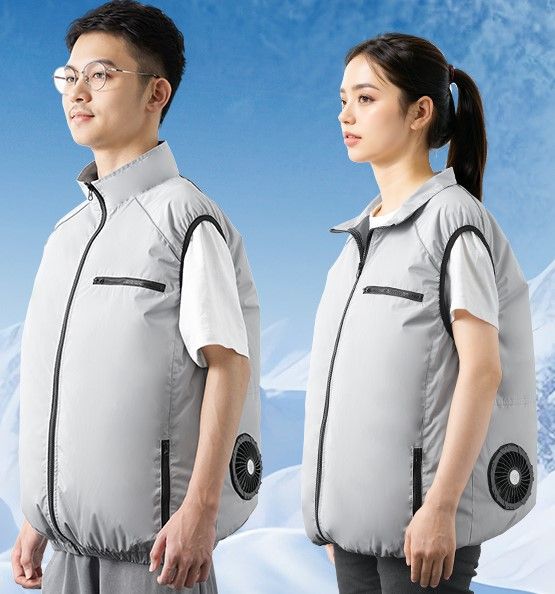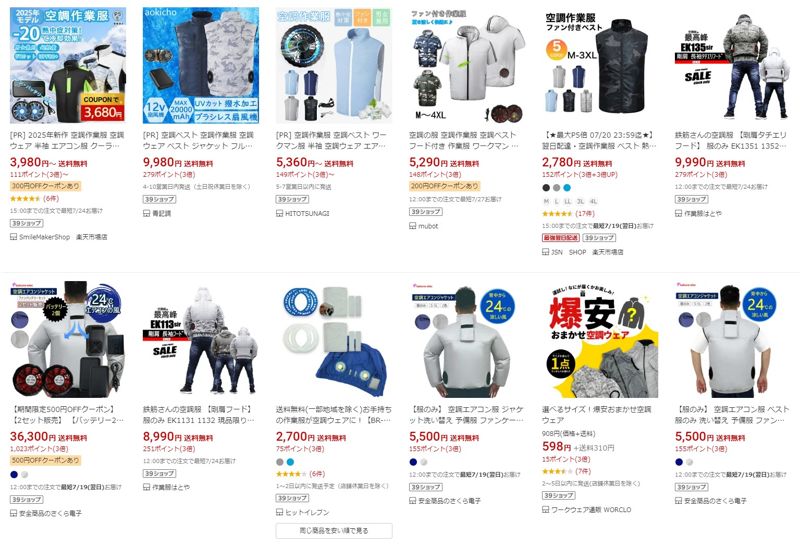"Heatwave Fashion?" Japanese People Finally 'Wear' Air Conditioners [Kim Kyung-min's Tokyo Honne]
- Input
- 2025-07-19 09:21:33
- Updated
- 2025-07-19 09:21:33
Air Conditioners You Wear on Hot Days
From Construction Sites to Runways
Whirring Sound, Now Cool
The Future of 'Wearable Technology'
From Construction Sites to Runways
Whirring Sound, Now Cool
The Future of 'Wearable Technology'

【Tokyo=Special Correspondent Kim Kyung-min】 The summer of 2025 in Tokyo is no exception to the heat. The name 'Cooling Shelter' has appeared in various parts of the city for over 10 years. The problem is that the heat doesn't dissipate even in the shade. At this point, people thought, "Can't we attach an air conditioner to our bodies?" Surprisingly, Japan actually did it. This summer, you can often see people on the streets wearing jumpers or shirts with small fans attached. These clothes, called 'Air Conditioner Clothes (エアコン服)', literally circulate air inside the body with a built-in fan to lower body temperature. Initially, they appeared as uniforms for construction sites or factory workers, but now they have expanded into everyday wear.
Clothes That Aren't Afraid of the Heat Have Really Appeared
The basic structure is surprisingly simple. Two small fans are attached to each side of the back of the waist, drawing in external air and circulating it inside. The principle is to induce coolness as sweat evaporates. The built-in battery is rechargeable and can be used for about 4-5 hours in strong wind mode.
Recently, cooling efficiency and design have also been evolving. Some premium products have adopted a method where the cooling panel itself becomes cold using Peltier elements, and battery performance has also improved significantly compared to the past. Shiftall, a subsidiary of Panasonic, has even launched a Peltier-based vest capable of both heating and cooling along with Walkman.
The interesting thing is that the fan motor sound has also become quieter. A few years ago, consumers were embarrassed by the "whirring" sound on the subway, but now they "completely ignore it." Somehow, in people's eyes, 'Air Conditioner Clothes = Cool Choice' has become.
Initially Workwear, Now Fashion?
The first to develop these air conditioner clothes was a Japanese small business 'Kuchofuku (空調服)'. In 2004, an engineer from a workwear company started developing it, saying "Factory workers are dying in the summer." Initially, it was hot, heavy, and had a short battery life, but as battery technology and fan noise improved, it began expanding for office, camping, and golf use.
At last year's functional fashion exhibition held at Tokyo Big Sight, there was a line over two hours long at the 'Air Conditioner Clothes' booth. Especially among Japanese teenage girls, these clothes are accepted as "tools that can be layered like fashion accessories." The billowing wind creates a 'hip silhouette'.
Even YouTubers are reviewing air conditioner clothes, filming dance challenges, or uploading concept videos like "Running on the Highway Wearing Air Conditioner Clothes." Unintentionally, it has become a new emotional item of 'function + fun' for Gen Z.

From 'Insider Item' to Essential Item?
Recently, Korean travelers also recognize these clothes as 'Japanese Summer Survival Items'. Especially among YouTubers cycling along the Han River, there are continuous certification shots of purchasing Japanese brand products. The reason being "more practical than portable fans and hands-free."
In Harajuku, a rental service for 'Air Conditioner Clothes' for foreigners has already appeared. 800 yen for half a day. It's a price worth considering if you're going to Disneyland in the heat.
'Air Conditioner Clothes' may become wearable technology in the era of climate change, beyond just a heat countermeasure. Japan is recording the highest average temperature every year. For now, it's at the level of light fans and batteries, but in a few years, clothes with refrigerant liquids, temperature sensors, and AI automatic control functions may be fully possible. Air conditioners, which were home appliances, are now evolving into 'wearable environmental equipment' worn on the body.
In Japan, there is a culture of 'Honne' (本音) and 'Tatemae' (建前). Honne is the true inner feelings, and Tatemae is the outward facade. Japanese people, who value organizational and social relationships over individuals, rarely reveal their Honne. Perhaps the Japan we see is just a fragment of Tatemae.
km@fnnews.com Kim Kyung-min Reporter